I will forgive you if you haven’t heard of the French town of Nantillois; after all, its current population is 64. Fortunately for us, two of those 64 are Maarten and Didi, a Dutch couple who moved to Nantillois eight years ago and opened a wonderful Bed & Breakfast. They are a great team: Didi runs the B & B, and cooks lovely dinners for guests; Maarten has a small World War I museum, a huge amount of knowledge about that war, and gives guided battle-site tours of the area. Both of them provide a warm welcome and a memorable stay. Hmmmm, sounds like a TripAdvisor review.
Anyway…Nantillois is about 20 miles north of Verdun, where the best-known battle of World War I took place: a ten-month affair that cost the French and Germans about 350,000 soldiers each and accomplished exactly nothing in terms of ground gained. There’s some stuff to see in that area, but we prefer being away from the tourist areas and this practice worked well for us here.
This is likely to be a long and maybe not too interesting post, especially if you’re not a history buff. I will not be (too) offended if you skip the rest.
A Quick Review of World War I
The centenary of the start of World War I has brought some recent interest in that war, but mostly it has been overshadowed by the second World War. A quick summary:
Leading up to 1914, almost all the countries of Europe entered into treaties with other countries, treaties that locked countries into defending each other should one of the countries be attacked. This became a huge and complicated web, and its result was that when, in June 1914, the Austrian Archduke Ferdinand was assassinated in Sarajevo, Bosnia, a long line of treaties were activated and brought all the European powers into conflict, culminating in early August when Germany declared war on Russia and France, and the response was Russia, France and Britain declaring war on Germany. The madness commenced.
Germany invaded France and Belgium with some success, pushing to the Marne River in France and establishing a line from Belgium southeast across France. But France and Britain stopped the German forces there and both sides “dug in,” building an astonishingly complex series of trenches to defend their lines. Often the front lines of these trenches were just a few hundred yards apart. For three years, there were skirmishes along those lines as one side or the other attempted to gain some territory, but essentially, the front moved very little and often at a profound cost in lives.
World War I differed profoundly from earlier wars; where war had always been a matter of conquering territory, WWI was a war of attrition: kill soldiers of the other side faster than they kill your soldiers. For four years, both sides tried to outlast and out-kill the other. It wasn’t until the United States entered the war in 1918 and sent 2 million fresh troops and $billions of new, state-of-the-art equipment that the west was able to finally overwhelm and push back the Germans. Once the big Allied assault began in September of 1918, it took less than 60 days to end the war.
Okay, enough background. We wanted to see and feel this history, and indeed we did. The first glimpse was in the Argonne Forest, where the trench lines had been the scene of four years of skirmishes. The first sight of a trench – many remain – was almost startling, like seeing a ghost of the past.
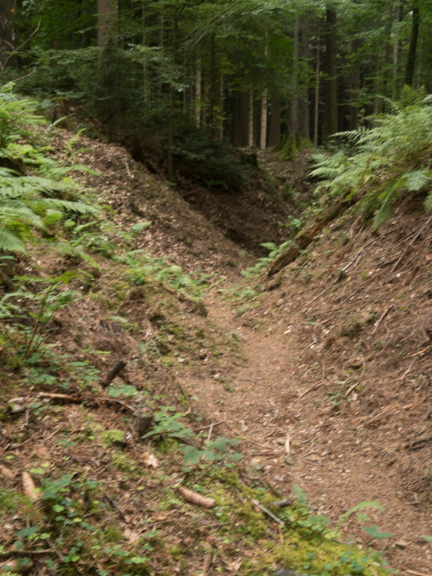 It has, of course, worn down over the years, but it’s still there and still eerie. Soldiers would rotate between the front-line trenches and safer camps a mile or so behind them. There are, in many places, huge complexes of trenches, with multiple parallel lines. In areas such as the Argonne Forest these lines would have been under almost constant shelling from artillery.
It has, of course, worn down over the years, but it’s still there and still eerie. Soldiers would rotate between the front-line trenches and safer camps a mile or so behind them. There are, in many places, huge complexes of trenches, with multiple parallel lines. In areas such as the Argonne Forest these lines would have been under almost constant shelling from artillery.
It’s something of a misnomer to have called this the Battle of the Argonne Forest because there wasn’t much forest left from early in the war; artillery destroyed it. Today the trees are all under one hundred years old and the usually-level ground of the forest still shows the effects of the bombing:
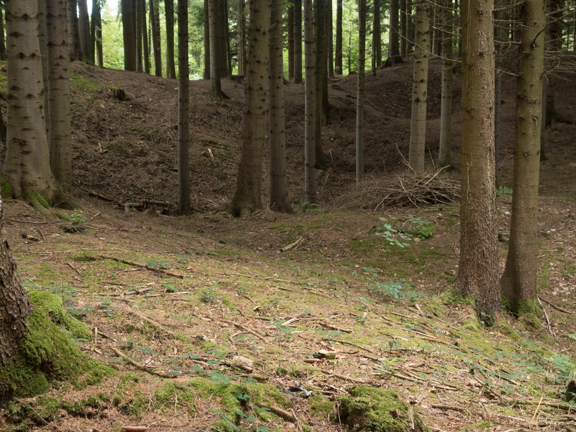
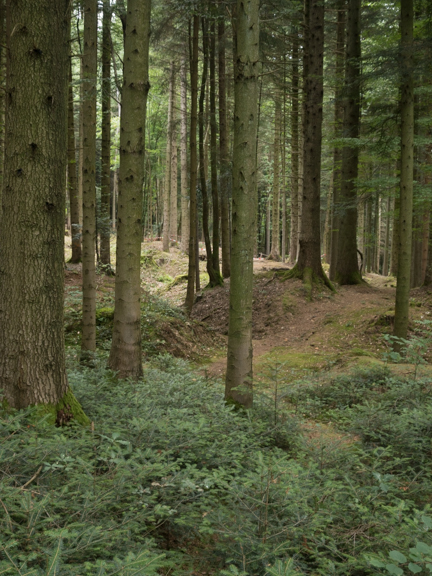 This picture was taken in 1917 in the same forest as the pictures above. Not much forest left.
This picture was taken in 1917 in the same forest as the pictures above. Not much forest left.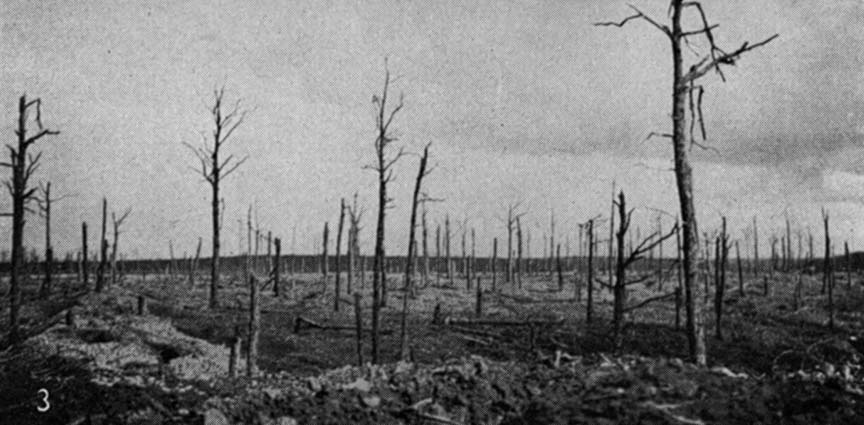 In late September 1918 the Allies – mostly France, Britain and the United States – started the offensive that would end the war. Nantillois was in German hands and had been for several years so the whole area was well defended. Maarten took us on a three-hour walking tour of the area, describing the battles as the American troops, responsible for pushing the Germans out of the region, progressed across the country-side. The picture below is at the edge of a forest; American soldiers came from the forest at the right (Montfaucon, which required two days to take and was so completely destroyed that the town was rebuilt half a mile away), across the hills and then to the forest on the right of the bottom picture, which looks in the opposite direction. The battle plan was to take all this in a day, but the defenses were much stiffer than expected, and a week was needed to clear this area.
In late September 1918 the Allies – mostly France, Britain and the United States – started the offensive that would end the war. Nantillois was in German hands and had been for several years so the whole area was well defended. Maarten took us on a three-hour walking tour of the area, describing the battles as the American troops, responsible for pushing the Germans out of the region, progressed across the country-side. The picture below is at the edge of a forest; American soldiers came from the forest at the right (Montfaucon, which required two days to take and was so completely destroyed that the town was rebuilt half a mile away), across the hills and then to the forest on the right of the bottom picture, which looks in the opposite direction. The battle plan was to take all this in a day, but the defenses were much stiffer than expected, and a week was needed to clear this area.
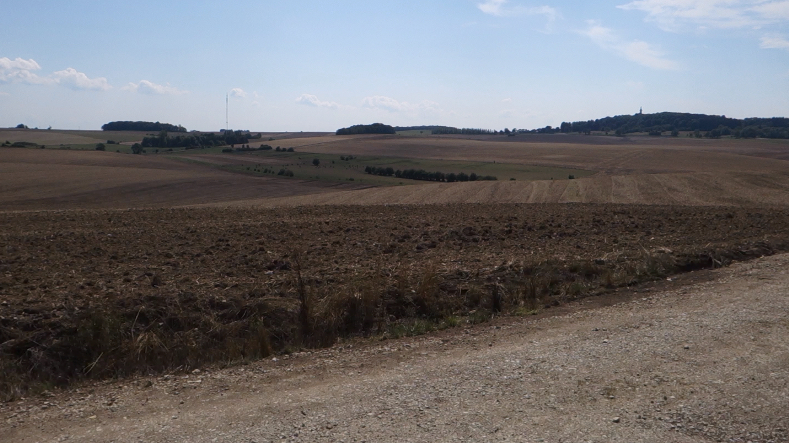

Here Maarten was invaluable, as he described the movement and difficulties and battles. We could stand there and envision the soldiers moving across the fields, encountering horrendous machine-gun fire from German forces dug into the top of each hill. It was cold, pouring rain, and the troops outran their supplies; some units went four days without food.
Maarten then took us through the forest. German troops had a large camp there, and were well dug-in.
American troops in the forest got a break when they had to wait for units alongside them to catch up. They dug foxholes and rested – as much as one can rest in a rain-filled hole. This area has hundreds of these foxholes still visible.
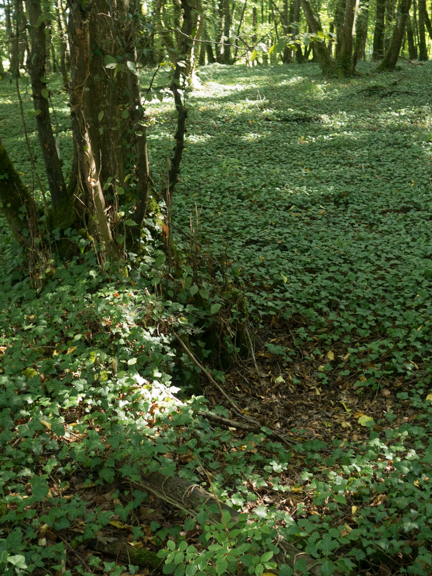
Maarten has discovered thousands of artifacts of the war and told us that walking through a freshly plowed field will always result in such discoveries. Laurie and I did that our last morning and in fifteen minutes found half a dozen such artifacts: a horseshoe, some pieces of a horse’s tackle, part of an artillery shell and some unidentifiable scrap.
We saw much more and visited several other very interesting sites, but enough is enough. I’ll leave you with just a couple more pictures.
It was moving to visit these sites, to be able to “see” the things that happened at each of them, to feel the human element. These weren’t just battles on a chess board; there were real people, just like us, doing their best in absolutely appalling conditions: they were hungry, cold, wet, bone-tired and, more than anything, they were scared all the time. We talk of sending men to war, but we don’t; we send boys. Most of the soldiers in these armies – on both sides – were eighteen or nineteen years old; tested veterans were twenty-one or twenty-two or twenty-three. These were kids, just trying to do their best and just trying to survive. Way, way too many did not:
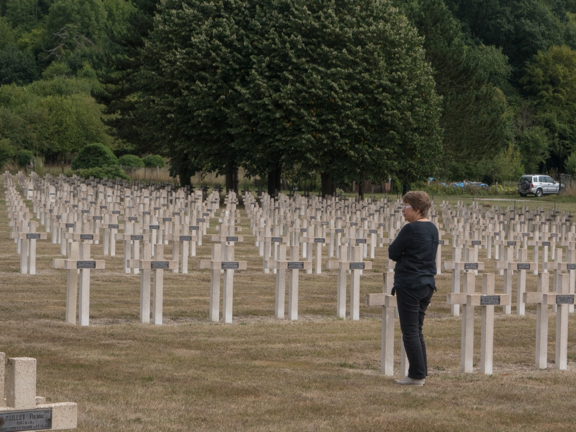
A cemetery for French soldiers. Here are buried 5,700 French soldiers; four-tenths of one percent of French losses in World War I.
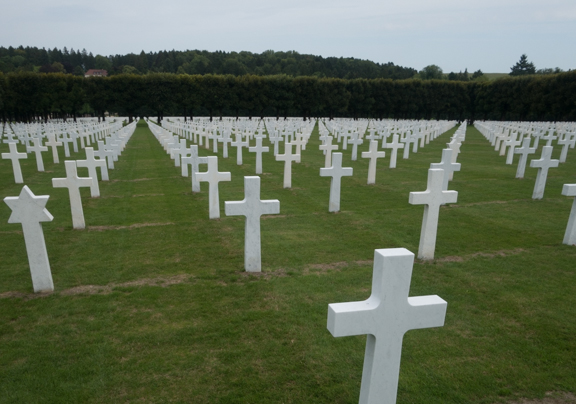
The American cemetery at Romagne-sous-Montfaucon. 14,267 American soldiers lie here. The rows seem sadly endless.
The United States lost 126,000 boys in World War I; France lost 1,375,000; Germany, 1,773,000; Russia, 1,700,000; Austria-Hungary, 1,200,000. No wonder Laurie and I have become more adamantly pacifist and non-violent as we’ve grown older. The only thing World War I accomplished was to set the stage for World War II, at a cost of 8.3 million soldiers killed and 19 million wounded.

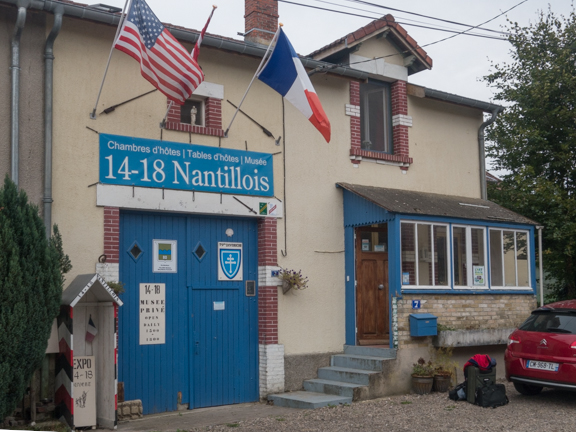
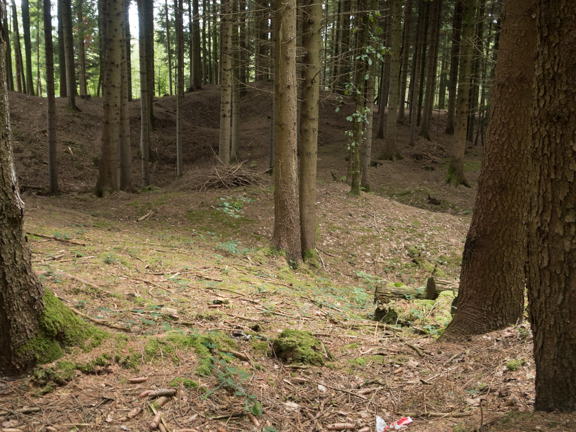

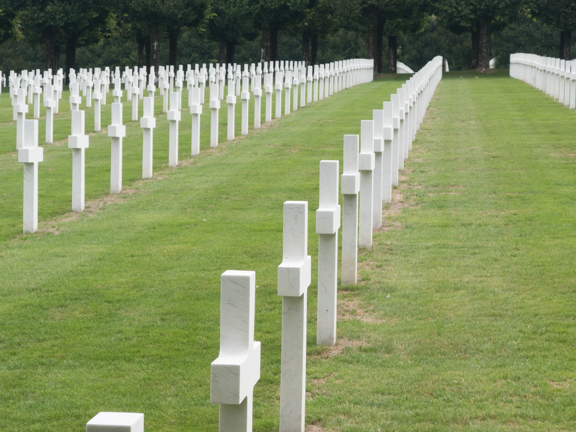
So very, very sad…interesting to see some of the battlefield areas/hideouts, etc.